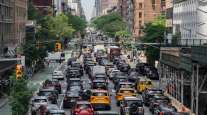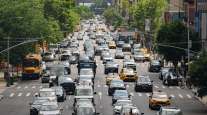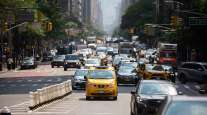Staff Reporter
L.A. Metro Will Consider Trucking Trends in Congestion Pricing Study

[Stay on top of transportation news: Get TTNews in your inbox.]
People who rely on vehicle travel for work — including freight haulers — will be considered as Los Angeles’ congestion pricing pilot program takes shape.
The Los Angeles County Metropolitan Transportation Authority is in the process of conducting a two-year Traffic Reduction Study, which considers managing traffic through congestion pricing and providing more transportation options. As the transportation agency of Los Angeles County, Metro represents about 9.6 million people.
During a virtual briefing Feb. 9, Tham Nguyen, senior director of Metro’s Office of Extraordinary Innovation, said the agency will identify and evaluate strategies to address the concerns of different types of travelers. Over the course of its ongoing public engagement, Nguyen said Metro has heard concerns from people who depend on their vehicles for work, such as delivery drivers, construction crew members, ride-share providers and gardeners.
As part of the Traffic Reduction Study, Metro is introducing 4 early concepts to see if a traffic reduction program pilot could be successful in our region. Learn more at an upcoming virtual meeting. https://t.co/Qf3U9OmmEg pic.twitter.com/twvXgMTrAH — LA Metro (@metrolosangeles) February 9, 2021
“We are starting our analysis to better understand the travel patterns,” Nguyen said. “We are engaging with folks from the freight and trucking industry. We’ll have more information, but first we’re just trying to understand what are the truck patterns. Where are people going?”
Other issues raised by constituents include travel time benefits, health, safety and environmental concerns. Nguyen said the team will continue to conduct public engagement activities to develop technical analysis and understand the impacts to daily commutes.
Metro’s team members indicated they are trying to understand a congestion pricing pilot’s burdens as well as its benefits, such as better trip reliability.

Schank
“The thing that is critical to remember about a congestion pricing scheme is that the benefits go not just to people who are switching to new transit alternatives, but also to people who continue to drive,” said Joshua Schank, chief innovation officer for the Office of Extraordinary Innovation. “When you’re driving on the routes that are now priced, you don’t sit in traffic, so you’re moving much faster. [For] folks from outside the area who continue to drive through the area, it’s not like they’re just getting charged and then continuing to have the same miserable experience they have now. They’re paying for real value.”
At the event, Nguyen presented four concept consideration areas Metro is studying. The first area covers the freeways that cross the Santa Monica Mountains between interstates 5 and 405 in central Los Angeles. Another similar option is smaller in scale, representing the area between U.S. Route 101 and I-5. The second and third concept areas are in downtown Los Angeles, which is bound by major routes such interstates 10 and 110 and U.S. 101. The fourth area is a corridor pricing model pertaining to the stretch of I-10 west of downtown Los Angeles.
Metro has scheduled three virtual community meetings throughout February to share input it has received and discuss the ways in which this input will shape the study moving forward.
Later this month, the project team will present the four concept areas to Metro’s board of directors. This summer, the team will present the Metro board with recommendations for a preferred concept, which will be one of the four concept areas.

Washington
Los Angeles is home to some of the worst traffic congestion in the country. The city is listed three times on the American Transportation Research Institute’s top truck bottlenecks report, which was released in February 2020. The intersection of state routes 60 and 57 ranked No. 9 on the list, while the intersection of interstates 710 and 105 came in at No. 10. The intersection of interstates 110 and 105 ranked No. 63.
Metro CEO Phillip Washington acknowledged that the COVID-19 pandemic has reduced traffic in the short term, but cautioned that long-term challenges include a higher population and increased congestion. Los Angeles Mayor Eric Garcetti announced Feb. 3 that Washington will step down in May.
“If we do not do anything, what we’re looking at is total gridlock,” Washington said. “We have a dream of this metamorphosis from a car capital of the world to a center for greater mobility, innovation and equity. We’re moving forward. We’re leaning forward in the foxhole.”
#ATRI Releases Annual List of Top 100 #Truck Bottlenecks https://t.co/iLSgQ7KacP #TruckBottlenecks #Infrastructure #Trucking #TruckingResearch — ATRI (@Truck_Research) February 19, 2020
Want more news? Listen to today's daily briefing below or go here for more info:




